Creating Main Windows in Qt Designer |
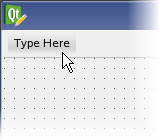 | 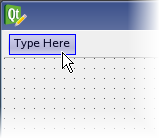 | Creating a Menu Double-click the placeholder item to start the editing process. The menu text is displayed using a line edit, and can be modified. |
 | 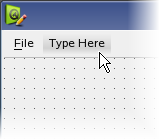 | Insert the required text for the new menu. Inserting an ampersand character (&) causes the letter following it to be used as a mnemonic for the menu. Press Return or Enter to accept the new text, or press Escape to reject it. You can undo the editing operation later if required. |
Menus can also be rearranged in the menu bar with simple drag and drop operations. Simply click and drag the menu you want to move, and drop it in the required location. A vertical red line indicates the position where the menu will be inserted.
Menus can contain any number of entries and separators, and can be nested to the required depth. Adding new entries to menus can be achieved by navigating the menu structure in the usual way.
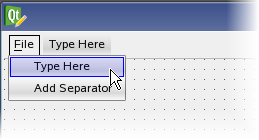 | 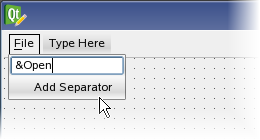 | Creating a Menu Entry Double-click the new action placeholder to start the editing process, or double-click new separator to insert a new separator line after the last entry in the menu. The menu entry's text is displayed using a line edit, and can be modified. |
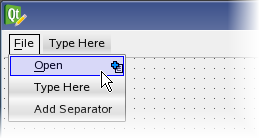 |  | Insert the required text for the new entry, optionally using the ampersand character (&) to mark the letter to use as a mnemonic for the entry. Press Return or Enter to accept the new text, or press Escape to reject it. The action created for this menu entry will be accessible via the Action Editor, and any associated keyboard shortcut can be set there. |
Just as with menus, entries can be moved around using drag and drop operations. When an entry is dragged over a closed menu, the menu will open to allow it to be inserted there. Since menu entries are based on actions, they can also be dropped onto toolbars, where they will be displayed as toolbar buttons.
Toolbars
Toolbars are added to a main window in a similar way to the menu bar: Select the Add Tool Bar option from the form's context menu. Alternatively, if there is an existing toolbar in the main window, you can click the arrow at its right-hand end to create a new toolbar.
Toolbar buttons are created by using the action system to populate each toolbar, rather than by using specific button widgets from the widget box. Since actions can be represented by menu entries and toolbar buttons, they can be moved between menus and toolbars. To share an action between a menu and a toolbar, drag its icon from the Action Editor to the toolbar rather than from the menu where its entry is located.
New actions for menus and toolbars can be created in the Action Editor.
Actions
With the menu bar and the toolbars in place, it's time to populate them with actions: Qt Designer provides an action editor to simplify the creation and management of actions.
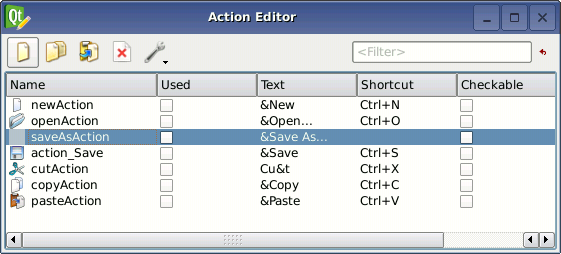 | The Action Editor Enable the action editor by opening the Tools menu, and switching on the Action Editor option. The action editor allows the user to create New actions, as well as deleting (Delete) actions. It also provides a search facility (Filter) using the action's text. Since Qt 4.4, Qt Designer's action editor can be viewed in the classic Icon View as well as Detailed View (see screenshot). You can also copy and paste actions between menus, toolbars and forms. |
To create an action, use the action editor's New button which will pop up an input dialog. Provide the new action with a Text. This is the text that will appear in a menu entry and as the actions tooltip. The text is also automatically added to an "action" prefix creating the action's Object Name.
In addition, the dialog provides the option of selecting an Icon for the action, as well as removing the current icon.
Once the action is created, it can be used wherever actions are applicable.
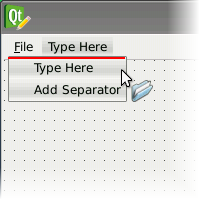 | 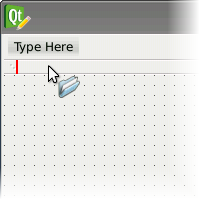 | Adding an Action To add an action to a menu or a toolbar, simply press the left mouse button over the action in the action editor, and drag it to where it is required. Qt Designer provides highlighted guide lines that tell you where the action will be added. Release the mouse button to add the action when you have found the right spot. |
Dock Widgets
Since dock widgets are container widgets, they can be added to a form in the usual way. When added to a form, dock widgets are not placed in any particular dock area by default; you need to set the docked property to true for each widget and choose an appropriate value for its dockWidgetArea property.
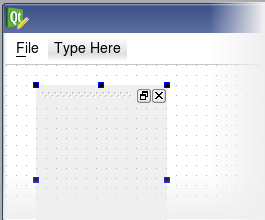 | Adding a Dock Widget To add a dock widget, simply drag one from the Containers section of the widget box, and drop it onto the main form area. Just as with other widgets, its properties can be modified with the Property Editor. Since dock widgets can be optionally floated as independent tool windows, it is useful to give them window titles by setting their windowTitle properties. This also helps to identify them on the form. |
[Previous: Using Containers in Qt Designer] [Contents] [Next: Qt Designer's Signals and Slots Editing Mode]
Best Of
Actualités les plus lues
- «Le projet de loi des droits du développeur» : quelles conditions doivent remplir les entreprises pour que le développeur puisse réussir ? 73
- Les développeurs détestent-ils les antivirus ? Un programmeur manifeste sa haine envers ces solutions de sécurité 27
- Une nouvelle ère d'IHM 3D pour les automobiles, un concept proposé par Digia et implémenté avec Qt 3
- Qt Creator 2.5 est sorti en beta, l'EDI supporte maintenant plus de fonctionnalités de C++11 2
- Vingt sociétés montrent leurs décodeurs basés sur Qt au IPTV World Forum, en en exploitant diverses facettes (déclaratif, Web, widgets) 0
- Thread travailleur avec Qt en utilisant les signaux et les slots, un article de Christophe Dumez traduit par Thibaut Cuvelier 1
- « Quelque chose ne va vraiment pas avec les développeurs "modernes" », un développeur à "l'ancienne" critique la multiplication des bibliothèques 102
- Pourquoi les programmeurs sont-ils moins payés que les gestionnaires de programmes ? Manquent-ils de pouvoir de négociation ? 53
- «Le projet de loi des droits du développeur» : quelles conditions doivent remplir les entreprises pour que le développeur puisse réussir ? 73
- Les développeurs détestent-ils les antivirus ? Un programmeur manifeste sa haine envers ces solutions de sécurité 27
- Qt Commercial : Digia organise un webinar gratuit le 27 mars sur la conception d'interfaces utilisateur et d'applications avec le framework 0
- Quelles nouveautés de C++11 Visual C++ doit-il rapidement intégrer ? Donnez-nous votre avis 10
- 2017 : un quinquennat pour une nouvelle version du C++ ? Possible, selon Herb Sutter 11

- Linus Torvalds : le "C++ est un langage horrible", en justifiant le choix du C pour le système de gestion de version Git 100
- Comment prendre en compte l'utilisateur dans vos applications ? Pour un développeur, « 90 % des utilisateurs sont des idiots » 229
- Quel est LE livre que tout développeur doit lire absolument ? Celui qui vous a le plus marqué et inspiré 96
- Apple cède et s'engage à payer des droits à Nokia, le conflit des brevets entre les deux firmes s'achève 158
- Nokia porte à nouveau plainte contre Apple pour violation de sept nouveaux brevets 158
- Quel est le code dont vous êtes le plus fier ? Pourquoi l'avez-vous écrit ? Et pourquoi vous a-t-il donné autant de satisfaction ? 83
- « Quelque chose ne va vraiment pas avec les développeurs "modernes" », un développeur à "l'ancienne" critique la multiplication des bibliothèques 101

Le Qt Developer Network au hasard

Combiner licence, à propos et fermer d'une autre manière
Communauté
Ressources
- 91 cours et tutoriels Qt
- F.A.Q. Qt : 200 questions et réponses
- 51 Qt Quarterly, 35 Qt Labs et 22 Qt DevNet en français
- 43 outils Qt
- 99 sources Qt et 26 binaires Qt
- 6 livres Qt et 9 critiques
- La documentation de Qt 4.7 en français : 157 classes, 70 concepts et 24 modules
- 3 certifications Qt
Liens utiles
Contact
- Vous souhaitez rejoindre la rédaction ou proposer un tutoriel, une traduction, une question... ? Postez dans le forum Contribuez ou contactez-nous par MP ou par email (voir en bas de page).
Qt dans le magazine
| Cette page est une traduction d'une page de la documentation de Qt, écrite par Nokia Corporation and/or its subsidiary(-ies). Les éventuels problèmes résultant d'une mauvaise traduction ne sont pas imputables à Nokia. | Qt 4.4 | |
| Copyright © 2012 Developpez LLC. Tous droits réservés Developpez LLC. Aucune reproduction, même partielle, ne peut être faite de ce site et de l'ensemble de son contenu : textes, documents et images sans l'autorisation expresse de Developpez LLC. Sinon, vous encourez selon la loi jusqu'à 3 ans de prison et jusqu'à 300 000 E de dommages et intérêts. Cette page est déposée à la SACD. | ||
| Vous avez déniché une erreur ? Un bug ? Une redirection cassée ? Ou tout autre problème, quel qu'il soit ? Ou bien vous désirez participer à ce projet de traduction ? N'hésitez pas à nous contacter ou par MP ! | ||
Copyright © 2000-2012 - www.developpez.com



















